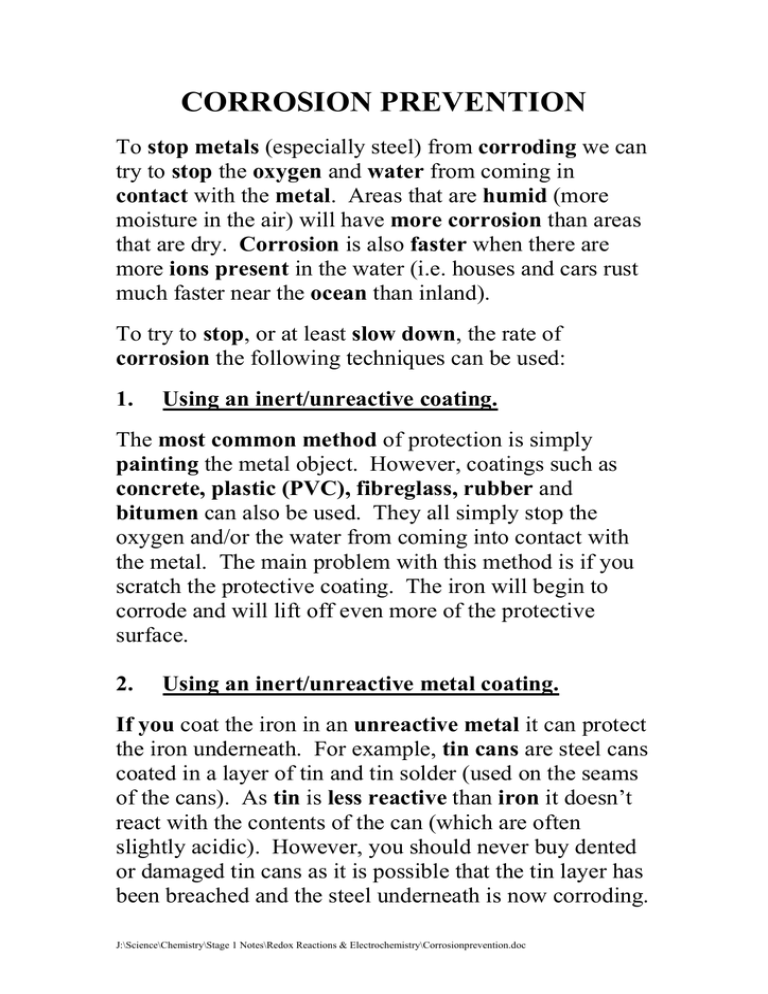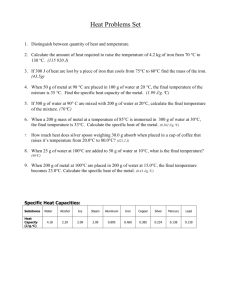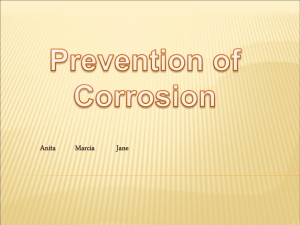CORROSION PREVENTION
advertisement

CORROSION PREVENTION To stop metals (especially steel) from corroding we can try to stop the oxygen and water from coming in contact with the metal. Areas that are humid (more moisture in the air) will have more corrosion than areas that are dry. Corrosion is also faster when there are more ions present in the water (i.e. houses and cars rust much faster near the ocean than inland). To try to stop, or at least slow down, the rate of corrosion the following techniques can be used: 1. Using an inert/unreactive coating. The most common method of protection is simply painting the metal object. However, coatings such as concrete, plastic (PVC), fibreglass, rubber and bitumen can also be used. They all simply stop the oxygen and/or the water from coming into contact with the metal. The main problem with this method is if you scratch the protective coating. The iron will begin to corrode and will lift off even more of the protective surface. 2. Using an inert/unreactive metal coating. If you coat the iron in an unreactive metal it can protect the iron underneath. For example, tin cans are steel cans coated in a layer of tin and tin solder (used on the seams of the cans). As tin is less reactive than iron it doesn’t react with the contents of the can (which are often slightly acidic). However, you should never buy dented or damaged tin cans as it is possible that the tin layer has been breached and the steel underneath is now corroding. J:\Science\Chemistry\Stage 1 Notes\Redox Reactions & Electrochemistry\Corrosionprevention.doc Nickel, gold and silver are often used as decorative coatings – they look attractive and they are very unreactive so they will not corrode. Some metals react with oxygen to form metal oxides that are tough and protect the metal underneath. The most common metals that do this are chromium (forms Cr2O3), aluminium (forms Al2O3) and nickel (forms NiO). The protective oxide layers that are formed are very unreactive and so prevent the metal underneath from corroding. This is why aluminium is such a good metal to be used for window frames. It is also why stainless steel (which contains both chromium and nickel) doesn’t corrode like steel does. In order to coat a metal (e.g. steel) in another metal to prevent corrosion, an electrolytic cell must be set-up. This particular type of electrolytic cell is known as electroplating. For example, if you wanted to coat a chair in chromium (i.e. chrome plating) you would need the following set-up: + Chromium block – anode - Cr3+ Object to be plated (i.e. chair) – cathode Chromium (i.e. Cr3+) solution Anode: Cr(s) → Cr3+(aq) + 3eCathode: Cr3+(aq) + 3e- → Cr(s) J:\Science\Chemistry\Stage 1 Notes\Redox Reactions & Electrochemistry\Corrosionprevention.doc 3. Using a sacrificial (more reactive) metal. Iron that is coated in zinc (i.e. galvanised iron) is also protected, even if the surface is scratched. This is because of the increased reactivity of zinc. Firstly, it forms its own zinc oxide (ZnO) coating. Secondly, if the iron is exposed, the zinc will oxidise in preference to the iron (because its more reactive), hence giving electrons to the iron, preventing corrosion. The redox reactions are as follows: Anode: Zn(s) → Zn2+(aq) + 2eCathode: Fe2+(aq) + 2e- → Fe(s) Overall: Zn(s) + Fe2+(aq) → Zn2+(aq) + Fe(s) The zinc donates its electrons to the iron, thus sacrificing itself to ensure that the iron doesn’t corrode. When all of the zinc is used up it will need to be replaced with another piece. This technique will work as long as the metal being used is more reactive, and hence willing to lose its electrons, more readily than iron. Magnesium metal blocks are often attached to the outside of the hull of boats to help prevent corrosion. The magnesium blocks must be replaced every 2 – 3 years (depending on the size of the ship and the size of the piece of Mg attached to it). J:\Science\Chemistry\Stage 1 Notes\Redox Reactions & Electrochemistry\Corrosionprevention.doc 4. Using electricity. Most motor vehicles and large sheet-metal objects get coated in surface rust during manufacture. It is removed by a quick dip in a tank of sulfuric acid. The tank of sulfuric acid could be made out of glass (as it would not react), but it would be very dangerous if it were damaged and broke. It is actually made out of steel. To stop the acid eating away at the tank it has a small voltage (about 4 – 6 V) applied to the walls of the tank. As electrons are supplied to the steel container, it is gaining, rather than losing electrons, and hence doesn’t corrode. It is a simple electrolytic cell, where the steel tank is made the cathode of the cell by supplying it with electrons. The anode can be anything cheap because it is going to be slowly eaten away in order to stop the tank from corroding. + ➀ ➂ ➀ ➁ ➂ = = = ➁ Sulfuric acid – H2SO4 Cheap metal anode (+ve terminal) Iron tank – cathode (-ve terminal) Any object needing surface rust removed J:\Science\Chemistry\Stage 1 Notes\Redox Reactions & Electrochemistry\Corrosionprevention.doc



